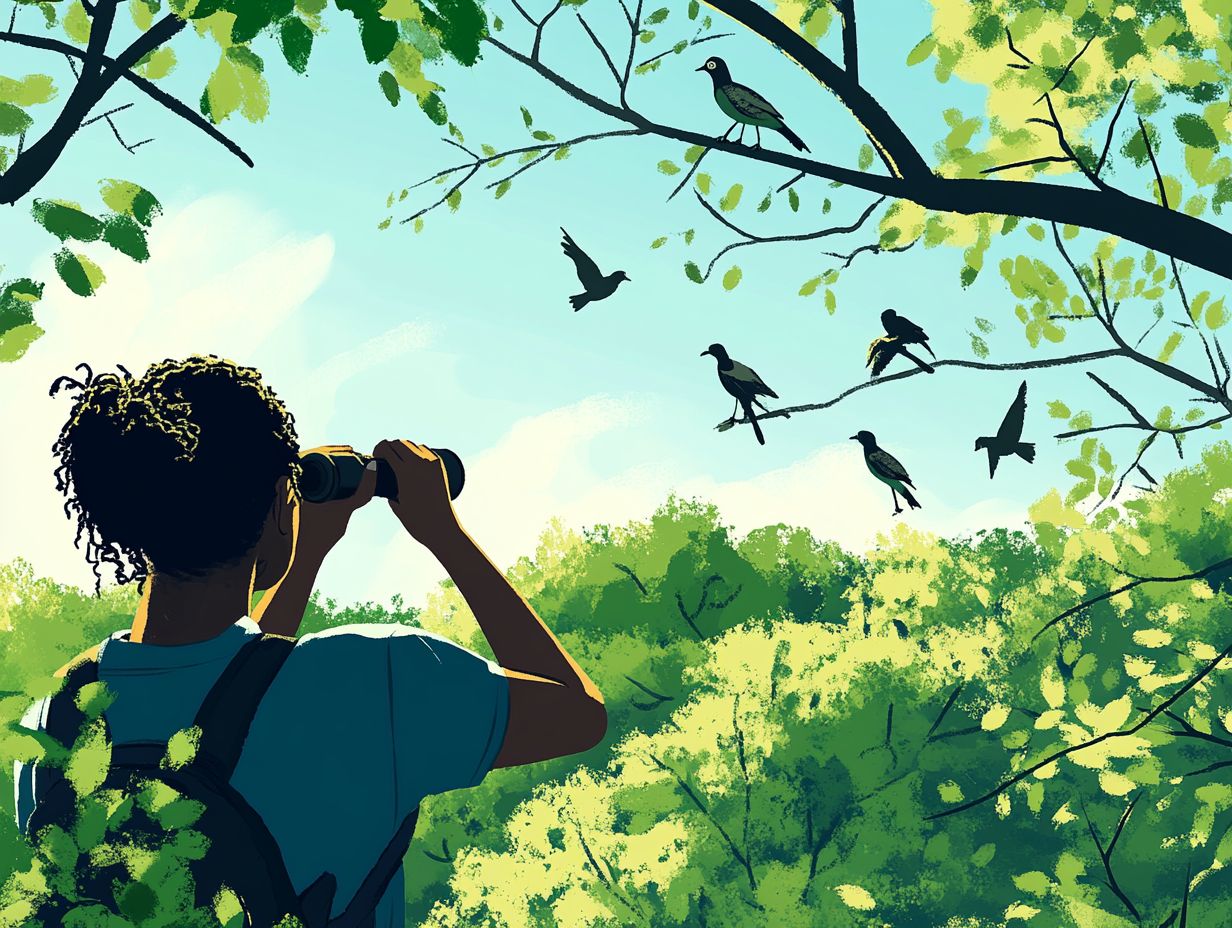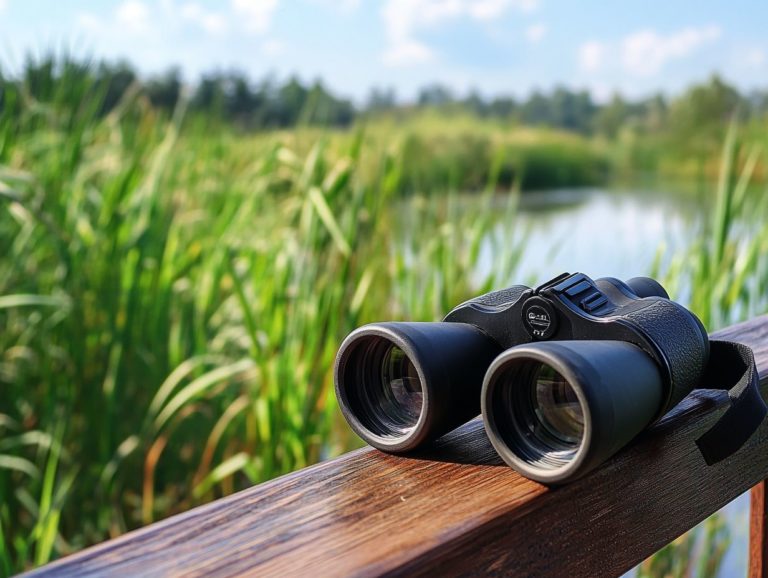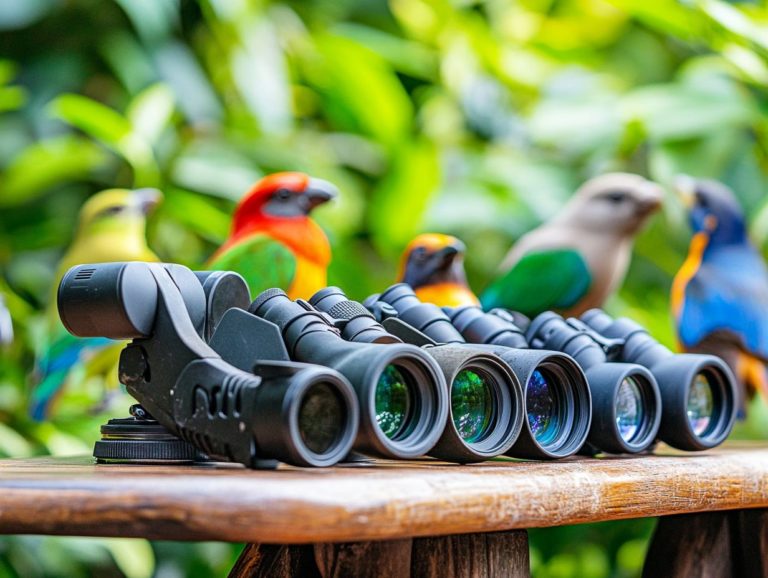How to Evaluate Binoculars for Bird Watching
Bird watching isn t just a hobby; it s an adventure waiting to unfold! Bird watching is an incredibly rewarding and immersive hobby, and having the right gear can elevate your experience to new heights.
Binoculars play a crucial role in enhancing your viewing experience, allowing you to connect with nature in ways you might not have imagined. However, with so many options on the market, choosing the perfect pair can feel a bit daunting. This guide will walk you through the essential factors to consider when selecting binoculars ranging from zoom to comfort ensuring that you make the best choice for your next birding adventure.
Serious birders will appreciate these insights.
Contents
- Key Takeaways:
- Factors to Consider when Choosing Binoculars
- Understanding Binocular Numbers
- Tips for Evaluating Binoculars in Person
- Other Features to Look for in Bird Watching Binoculars
- Frequently Asked Questions
- What are the important factors to consider when evaluating binoculars for birdwatching?
- How does magnification affect the quality of binoculars for birdwatching?
- Why is lens size important when choosing binoculars for birdwatching?
- What is field of view and how does it impact birdwatching?
- How can I test the image quality of binoculars for birdwatching?
- Are there any additional features to consider when evaluating binoculars for birdwatching?
Key Takeaways:

- When choosing binoculars for bird watching, consider factors such as zoom, prism type, and weight.
- Understand the numbers associated with binoculars, like zoom and field of view (the width of the area you can see through the binoculars), to find the right fit.
- When evaluating binoculars, test for comfort, ease of use, and image quality. Look for waterproofing and focus adjustment for a better experience.
Why Use Binoculars for Bird Watching?
Using binoculars for bird watching elevates your birding experience, allowing you to fully observe and appreciate the stunning beauty of avian species in their natural habitats. To enhance your experience further, consider these tips for choosing binoculars for bird photography. These important tools for birdwatching provide the zoom and clarity you need to identify everything from the most common birds to rare finds.
If you’re often wandering through places like Central Park in New York or taking part in events organized by the Audubon Society, investing in quality binoculars from reputable retailers such as B&H Photo or exploring options like Leica Ultravid or Swarovski is key to enhancing your viewing experience.
The benefits of these optical instruments go far beyond just magnification; they offer remarkable portability, making it easy to take them along on hikes or outings. Many communities, including local birdwatching clubs and organizations like the US Fish and Wildlife Service, promote the responsible observation of wildlife while minimizing disruption to their natural habitats.
With binoculars in hand, you can maintain a respectful distance from the creatures you admire, facilitating a more genuine and less intrusive interaction.
High-quality optics provide improved image stability and brightness, enriching your observation process. This allows you to share your experiences and engage in discussions with fellow enthusiasts, fostering a sense of camaraderie within the birding community, especially when using renowned brands like Canon EF 600mm or Eric Lind’s preferences.
Factors to Consider when Choosing Binoculars
Choosing the right binoculars is essential for any birder, as several factors distinctly impact performance and usability. When considering binoculars, pay close attention to specifications such as zoom levels, field of view, and minimum focus distance; these elements play a crucial role in how effectively you can spot and identify birds. For more guidance, check out this detailed article on how to select binoculars for bird watching tours.
The binoculars you choose should be portable and easy to carry on your birding trips. Engaging with organizations like the US Fish and Wildlife Service can further enhance your understanding, providing valuable insights into the best practices for selecting binoculars tailored to your specific needs.
Magnification and Field of View
The magnification of your binoculars is vital for powerful viewing. It directly influences how close and detailed your observed subjects appear. This is especially important for birders who want to appreciate every feather and behavior.
For instance, the popular 8×42 binoculars offer a perfect balance between magnification and field of view. This balance impacts how much of the scene you can take in at once. Understanding these specifications can truly elevate your birding experience.
If you choose higher magnifications, such as 10×42, you’ll enjoy an even closer look. However, this comes with a narrower field of view, making it tricky to track fast-moving birds. On the other hand, binoculars with lower magnification provide a broader view ideal for scanning open fields or large flocks, especially when using zoom binoculars.
With various configurations available, such as compact models for portability or wide-angle designs for breathtaking landscapes, you can tailor your equipment to your environment. A thoughtful choice between magnification levels can enhance your observational pleasure and effectiveness in the field.
Prism Type and Lens Coating
The type of prism you choose whether a Porro prism or a roof prism is crucial for shaping your optical experience. It affects light gathering power and overall usability. Porro prisms generally provide superior light-gathering capabilities and a wider field of view. They are great if you value expansive vistas.
In contrast, roof prisms offer a sleek, streamlined design, appealing to birders who prioritize portability without sacrificing functionality. Don t overlook lens coatings; they can significantly enhance image brightness and clarity, transforming your birding outings.
When assessing your specific needs, carefully weigh the pros and cons of each option. For example, while Porro prisms may have a bulkier profile, they often excel in depth perception. This is invaluable for tracking swift, elusive birds in the field, especially in famous locations like New York. Conversely, the slender design of roof prisms makes them easier to carry and more comfortable to handle during extended observation sessions.
Lens coatings, particularly fully multi-coated lenses, greatly influence not only image clarity but also color fidelity. This is key for accurately identifying various bird species in their natural settings.
Weight and Size

The weight and size of binoculars are crucial for birders, especially if you enjoy long hours of observation in diverse terrains. Choosing lightweight and compact models, like the popular 8×42 binoculars, gives you the convenience of portability without sacrificing performance. This balance allows you to carry your optical tool effortlessly, keeping fatigue at bay during extended adventures.
Selecting the right pair can transform your birding experiences. It’s essential to evaluate how these features correspond with your specific activities. For example, while heavier models may be better for stationary observation where stability enhances image clarity, they can become cumbersome on hikes or travels. To find the perfect fit, consider the best binoculars for backyard bird watching.
Your comfort preferences play a pivotal role. A snug grip and an ergonomically designed shape make prolonged use much more enjoyable, especially for serious birders who spend hours outdoors.
Ultimately, choosing the right binoculars that align with size and weight can refine your birding endeavors and enhance your experience. For those interested in group activities, learning how to use binoculars for bird watching in groups can transform your exploration of the natural world into a more fulfilling adventure.
Understanding Binocular Numbers
Grasping binocular numbers is essential for birders, allowing you to decipher the specifications of your optical instruments, such as 8x and 10x magnifications. These numbers indicate both the magnification and the objective lens diameter.
Take, for instance, 8×42 binoculars: the ‘8’ signifies the magnification power, while the ’42’ represents the diameter of the objective lens in millimeters. Understanding this information enables you to choose the right equipment tailored to your observation needs.
Decoding the Specifications
Decoding the specifications of binoculars involves more than just grappling with magnification. It encompasses vital parameters like minimum focus distance, eye relief, and objective diameter all crucial for enhancing your birding experience.
These specifications can dramatically change how you see and enjoy the great outdoors! For instance, a shorter minimum focus distance allows you to observe birds at closer ranges, making it easier to appreciate intricate details like feather patterns.
On the flip side, having sufficient eye relief ensures you can comfortably view the entire field without any strain, especially if you wear glasses, enhancing your overall experience.
Similarly, a larger objective diameter captures more light, providing brighter, clearer images in low-light conditions crucial during those magical hours of dawn or dusk when many birds are most active, like during organized events by the Audubon Society. By grasping these parameters, you can select binoculars tailored to your unique needs, ultimately elevating your passion for avian observation to new heights.
Tips for Evaluating Binoculars in Person
Don’t miss the chance to test binoculars in person! This step is key to ensuring you make the best choice for your birding adventures, particularly in terms of comfort and image quality, which can vary significantly between models like Leica Ultravid and Swarovski.
When you test binoculars, pay close attention to factors such as grip, weight distribution, and ease of use, in addition to visual clarity and brightness. For more detailed insights, consider what to look for when buying birding binoculars. This hands-on approach enables you to make informed decisions, guaranteeing that your optical tool enhances your birding experience to the fullest.
Testing for Comfort and Ease of Use
When evaluating binoculars, pay attention to factors such as grip, weight distribution, and ergonomic design—a design that fits comfortably in your hands. To ensure you make the right choice, consider how to test binoculars before buying them. These elements together can significantly enhance your overall experience, allowing you to stay focused on your surroundings instead of wrestling with your equipment.
To elevate that experience, seek binoculars with a textured grip. This feature minimizes slipping, particularly beneficial during extended observations. Consider the overall weight as well; lighter models can help reduce fatigue, making your viewing sessions far more enjoyable.
When holding your binoculars, tuck your elbows against your body for added stability, and use the forehead rest to enhance both comfort and alignment. Don’t overlook adjustable diopters and eye relief settings. These elements are crucial for personalizing your optics, ensuring a clearer and more relaxed sighting experience. Remember, features like magnification binoculars can also make a significant difference in your observations.
Assessing Image Quality

For birders, assessing image quality is crucial. High-quality optics provide clear, bright images that reveal intricate details and vibrant colors.
This enhances your ability to identify species noted in eBird, a vital resource for birders.
Key features for optimal image quality include the lenses. A special type of glass that lets in more light significantly improves brightness.
Coatings, such as anti-reflective options, reduce glare and improve contrast. Pay attention to the field of view and depth of field when selecting optics.
Consider models from top brands like Leica Ultravid and Swarovski for exceptional quality.
To truly assess image quality, conduct hands-on tests in various lighting conditions. Focus on clarity and sharpness across the entire field of view.
This enables you to make informed choices that elevate your birding adventures. Consult reviews from trustworthy sources like B&H Photo for additional insights.
Other Features to Look for in Bird Watching Binoculars
When searching for bird-watching binoculars, consider several additional features. Look for attributes like waterproofing, durability, and focus adjustment mechanisms.
These elements are especially beneficial for birders, who often venture into diverse outdoor conditions.
Consider Porro prism designs for better stability and depth perception.
Such features ensure your optical tool remains functional and reliable, no matter where your adventures take you.
Waterproofing and Durability
Waterproofing and durability are critical for bird-watching binoculars. They must withstand various environmental conditions while delivering optimal performance.
Look for binoculars sealed against moisture and dust, allowing you to use them confidently in all weather.
A key feature is adherence to industry standards, like the IPX7 rating. This guarantees your binoculars can be submerged in water up to one meter for a limited time without damage.
This ensures that your optics impress even the toughest organizations like the Audubon Society and the US Fish and Wildlife Service.
Brands like Nikon and Zeiss have crafted models that frequently exceed these standards. The Nikon Monarch 7 and Zeiss Conquest HD are shining examples praised by experts.
Both models provide outstanding waterproof performance and rugged durability, making them ideal companions for any enthusiastic bird watcher.
If you’re looking for alternatives, consider the Canon EF 600mm for spotting distant wildlife.
Explore your options today and elevate your birding experience!
Focus and Diopter Adjustment
Focus and diopter adjustment are essential features in birdwatching binoculars. They enable you to achieve sharp, clear images tailored to your unique vision needs. Fine-tuning focus and compensating for sight differences can elevate your viewing experience, making your birding outings enjoyable and productive.
To make the most of these features, start by setting the focus on a stationary object at a distance, preferably in natural light. This ensures you get the clearest image possible. Next, use the diopter adjustment to balance the view between both eyes, ensuring both views are equally sharp. High-quality optical tools typically offer smooth, precise adjustment mechanisms for minor changes without slipping or shifting, enhancing your experience.
When selecting your binoculars, choose models with a wide field of view and sufficient magnification. These factors are key to spotting and identifying elusive species, and for more insights, check out understanding binocular specifications for birders, ensuring you don’t miss a thing during your birdwatching adventures.
Frequently Asked Questions
What are the important factors to consider when evaluating binoculars for birdwatching?

Consider the following factors when evaluating binoculars for birdwatching:
- Magnification
- Lens size
- Field of view
- Image quality
A lens size of at least 40mm is typically recommended for optimal results.
How does magnification affect the quality of binoculars for birdwatching?
Magnification is crucial in evaluating binoculars. Higher magnification allows you to see birds up close but can also make the image shakier and harder to focus. For tips on finding the right balance, refer to this guide on how to pick binoculars for birding tours for a clear view.
Why is lens size important when choosing binoculars for birdwatching?
The lens size determines how much light enters the binoculars, affecting brightness and clarity. Choose binoculars with a lens size of at least 40mm for an enhanced viewing experience.
What is field of view and how does it impact birdwatching?
Field of view refers to the width of the area visible through the binoculars. A wider field of view allows you to see more birds and their surroundings, making it easier to track movements. This is especially important for observing species in the field.
How can I test the image quality of binoculars for birdwatching?
The best way to test image quality is to look through the binoculars and compare clarity, sharpness, and color accuracy. For a comprehensive assessment, you should examine objects at various distances and lighting conditions. Additionally, consider how to use binoculars for bird watching safely and check the binocular specifications to ensure they meet your needs.
Are there any additional features to consider when evaluating binoculars for birdwatching?
Consider the following additional features:
- Weight: Lighter binoculars are more comfortable for long trips.
- Comfort: Ensure good eye relief for prolonged use.
- Durability: Choose waterproof options for outdoor use.
Stay updated with the latest models from brands like Leica Ultravid and Swarovski to ensure you re well-equipped for your adventures.






